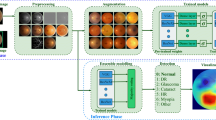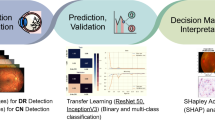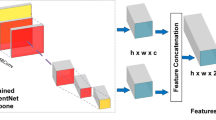Abstract
Most diabetes patients are liable to have diabetic retinopathy (DR); however, the majority of them might not be even aware of the ailment. Therefore, early detection and treatment of DR are necessary to prevent vision loss. But, avoiding DR is not a simple process. An ophthalmologist can typically identify DR through an optical evaluation of the fundus and through the evaluation of color pictures. However, due to the increased count of DR patients, this could not be possible as it consumes more time. To rectify this problem, a novel deep ensemble-based DR classification technique is developed in this work. Initially, a Wiener filter (WF) is applied for preprocessing the image. Then, the enhanced U-Net-based segmentation process is done. Subsequent to the segmentation process, features are extracted that include statistical features, inferior superior nasal temporal (ISNT), cup to disc ratio (CDR), and improved LGBP as well. Further, deep ensemble classifiers (DEC) like CNN, Bi-GRU, and DMN are used to recognize the disease. The outcomes from DMN, CNN, and Bi-GRU are then subjected to improved SLF. Additionally, the weights of DMN, CNN, and Bi-GRU are adjusted via pelican updated Tasmanian devil optimization (PU-TDO). Finally, outputs on DR (microaneurysms, hemorrhages, hard exudates, and soft exudates) are obtained. The performance of DEC + PU-TDO for diabetic retinopathy is computed over extant models with regard to different measures for four datasets. The results on accuracy using the DEC + PU-TDO scheme for the IDRID dataset is maximum around 0.975 at 90th LP while other models have less accuracy. The FPR of DEC + PU-TDO is less around 0.039 at the 90th LP for the SUSTech-SYSU dataset, while other extant models have maximum FPR.
Graphical Abstract




















Similar content being viewed by others
Data availability
The data gathered for this research is accessible in https://rrc.cvc.uab.es/?ch=3&com=downloads.
Abbreviations
- ANN:
-
Artificial neural network
- AHE:
-
Adaptive histogram equalization
- AOA:
-
Arithmetic optimization algorithm
- BCE:
-
Binary cross entropy
- Bi-GRU:
-
Bidirectional gated recurrent unit
- CLAHE:
-
Contrast limited adaptive histogram equalization
- CNN:
-
Convolutional NN
- CDR:
-
Cup to disc ratio
- CMBO:
-
Cat and mouse-based optimizer
- DNN:
-
Deep neural network
- DCNNs:
-
Deep convolutional neural networks
- DR:
-
Diabetic retinopathy
- DL:
-
Deep learning
- DEC:
-
Deep ensemble classifiers
- DMN:
-
Deep max network
- e2e:
-
End-to-end
- HIMLA:
-
Hybrid inductive machine learning algorithm
- HGS:
-
Hunger games search
- HE:
-
Histogram equalization
- IRes-V2 DNN:
-
Inceptionresnet-V2 deep neural network
- FCM:
-
Fuzzy means clustering
- GAM:
-
Gated attention mechanism
- ISNT:
-
Inferior superior nasal temporal
- ML:
-
Machine learning
- LGBP:
-
Local Gabor binary pattern
- TL:
-
Transfer learning
- LP:
-
Learning percentage
- LBP:
-
Local binary pattern
- POA:
-
Pelican optimization
- PU-TDO:
-
Pelican updated Tasmanian devil optimization
- NN:
-
Neural networks
- SD:
-
Standard deviation
- SSO:
-
Simplified swarm optimization
- SSOA:
-
Shuffled shepherd optimization algorithm
- SVM:
-
Support vector machine
- SLF:
-
Score level fusion
- TDO:
-
Tasmanian devil optimization
- RNN:
-
Recurrent neural network
- WF:
-
Wiener filter
References
Bhardwaj C, Jain S, Sood M (2021) Deep learning–based diabetic retinopathy severity grading system employing quadrant ensemble model. J Digit Imaging 34:440–457
Bhardwaj C, Jain S, Sood M (2021) Transfer learning based robust automatic detection system for diabetic retinopathy grading. Neural Comput & Applic 33:13999–14019
Raja C, Balaji L (2019) An automatic detection of blood vessel in retinal images using convolution neural network for diabetic retinopathy detection. Pattern Recogn Image Anal 29:533–545
Chakraborty S (2020) Gopal Chandra Jana, Divya Kumari & Aleena Swetapadma, "An improved method using supervised learning technique for diabetic retinopathy detection". Int J Inf Technol 12:473–477
Bodapati JD (2021) Nagur Shareef Shaik & Veeranjaneyulu Naralasetti, "Composite deep neural network with gated-attention mechanism for diabetic retinopathy severity classification". J Ambient Intell Humaniz Comput 12:9825–9839
Dutta A, Agarwal P, Mittal A, Khandelwal S (2021) Detecting grades of diabetic retinopathy by extraction of retinal lesions using digital fundus images. Res Biomed Eng 37:641–656
Mahmoud MH, Salman Alamery H, Fouad AA, Youssef AE (2021) An automatic detection system of diabetic retinopathy using a hybrid inductive machine learning algorithm. Pers Ubiquit Comput 27:751–765
Alaguselvi R, Murugan K (2021) Performance analysis of automated lesion detection of diabetic retinopathy using morphological operation. SIViP 15:797–805
Li X, Shen L, Shen M, Tan F, Qiu CS (2019) Deep learning based early stage diabetic retinopathy detection using optical coherence tomography. Neurocomputing 3695:134–144
Manuel E, Gegundez-Arias DM, Ponte B, Alvarez F, Bravo JM (2017) A tool for automated diabetic retinopathy pre-screening based on retinal image computer analysis. Comput Biol Med 88:100–109
Zago GT, Andreão RV, Dorizzi B, Salles EOT (January 2020) Diabetic retinopathy detection using red lesion localization and convolutional neural networks. Comput Biol Med 116:103537
Gräsbeck TC, Gräsbeck SV, Miettinen PJ, Summanen PA (2016) Fundus photography as a screening method for diabetic retinopathy in children with type 1 diabetes: outcome of the initial photography. Am J Ophthalmol 169:227–234
Garima Gupta S (2017) Kulasekaran, Keerthi Ram, Niranjan Joshi, Rashmin Gandhi, “Local characterization of neovascularization and identification of proliferative diabetic retinopathy in retinal fundus images”. Comput Med Imaging Graph 55:124–132
Kumar S, Adarsh A, Kumar B, Singh AK (January 2020) An automated early diabetic retinopathy detection through improved blood vessel and optic disc segmentation. Optics & Laser Technol 121:105815
Shanthi T, Sabeenian RS (2019) Modified Alexnet architecture for classification of diabetic retinopathy images. Comput Electr Eng 76:56–64
Wan S, Liang Y, Zhang Y (2018) Deep convolutional neural networks for diabetic retinopathy detection by image classification. Comput Electr Eng 72:274–282
Pinazo-Durán MD, Shoaie-Nia K, Sanz-González SM, Raga-Cervera J Identification of new candidate genes for retinopathy in type 2 diabetics. Valencia Study on diabetic retinopathy (VSDR). Report number 3. Arch Soc Española de Oftalmol 93(5):211–219
Qiao L, Zhu Y, Zhou H (2020) Diabetic retinopathy detection using prognosis of microaneurysm and early diagnosis system for non-proliferative diabetic retinopathy based on deep learning algorithms. IEEE Access 8:104292–104302. https://doi.org/10.1109/ACCESS.2020.2993937
Peter L. Nesper, Brian T. Soetikno, Hao F. Zhang, Amani A. Fawzi, “OCT angiography and visible-light OCT in diabetic retinopathy”, Vis Res, vol. 139, pp. 191-203, October 2017.
Bruna Letícia da Silva Pereira (2018) Evelise Regina Polina, Daisy Crispim, Renan Cesar Sbruzzi, Kátia Gonçalves dos Santos, “Interleukin-10 −1082A > G (rs1800896) polymorphism is associated with diabetic retinopathy in type 2 diabetes”. Diabetes Res Clin Pract 138:187–192
Xiao Z, Xing H, Qu R, Feng L, Luo S, Zhao B, Dai Y (2024) Densely knowledge-aware network for multivariate time series classification. IEEE Trans Syst Man Cybern Syst. https://doi.org/10.1109/TSMC.2023.3342640
Xiao Z (2024) Deep contrastive representation learning with self-distillation. IEEE Transactions on Emerging Topics in Computational Intelligence 8(1):3–15. https://doi.org/10.1109/TETCI.2023.3304948
Xiao Z, Tong H, Qu R, Xing H, Luo S, Zhu Z (2023) CapMatch: Semi-supervised contrastive transformer capsule with feature-based knowledge distillation for human activity recognition. IEEE Trans Neural Netw Learn Syst. https://doi.org/10.1109/TNNLS.2023.3344294
Adam M, Ng EYK, Tan JH, Heng ML, Acharya UR (2017) Computer-aided diagnosis of diabetic foot using infrared thermography: a review. Comput Biol Med 91:326–336
Abdelsalam MM, Zahran MA (2021) A novel approach of diabetic retinopathy early detection based on multifractal geometry analysis for OCTA macular images using support vector machine. IEEE Access 9:22844–22858. https://doi.org/10.1109/ACCESS.2021.3054743
Nalini M, Raghavulu BV, Annapurna A, Avinash P, Wasim (2017) Correlation of various serum biomarkers with the severity of diabetic retinopathy. Diabetes Metab Syndr Clin Res Rev 11(Supplement 1):s451–s454
Blum A, Pastukh N, Socea D, Jabaly H (2018) Levels of adhesion molecules in peripheral blood correlate with stages of diabetic retinopathy and may serve as biomarkers for microvascular complications. Cytokine 106:76–79
Desai J, Taylor G, Vazquez-Benitez G, Vine S, O'Connor PJ (2017) Financial incentives for diabetes prevention in a Medicaid population: study design and baseline characteristics. Contemp Clin Trials 53:1–10
Hua C-H, Kim K, Huynh T, In You J, Seung-Young Y, Le-Tien T, Bae S-H, Lee S (2021) Convolutional network with twofold feature augmentation for diabetic retinopathy recognition from multi-modal in. IEEE J Biomed Health Inform 25(7):2686–2697. https://doi.org/10.1109/JBHI.2020.3041848
Wang S, Wang X, Hu Y, Shen Y (2021) Diabetic retinopathy diagnosis using multichannel generative adversarial network with semisupervision. IEEE Trans Autom Sci Eng 18(2):574–585. https://doi.org/10.1109/TASE.2020.2981637
Sun Y, Zhang D (2019) Diagnosis and analysis of diabetic retinopathy based on electronic health records. IEEE Access 7:86115–86120. https://doi.org/10.1109/ACCESS.2019.2918625
Imran A, Li J, Pei Y, Yang J-J, Wang Q (2019) Comparative analysis of vessel segmentation techniques in retinal images. IEEE Access 7:114862–114887. https://doi.org/10.1109/ACCESS.2019.2935912
Bernabé O, Acevedo E, Acevedo A, Carreño R, Gómez S (2021) "Classification of eye diseases in fundus images," IEEE. Access 9:101267–101276. https://doi.org/10.1109/ACCESS.2021.3094649
Zhang W, Zhong J, Yang S, Gao Z, Hu J, Chen Y, Yi Z (2019) Automated identification and grading system of diabetic retinopathy using deep neural networks. Knowl-Based Syst 175:12–25
Bader Alazzam M, Alassery F, Almulihi A (2021) Identification of diabetic retinopathy through machine learning. Mob Inf Syst 2021:1–8
Jinfeng G, Qummar S, Junming Z, Ruxian Y, Khan FG (2020) Ensemble framework of deep CNNs for diabetic retinopathy detection. Comput Intell Neurosci 2020:1–11
Albadr MAA, Ayob M, Tiun S, Al-Dhief FT, Hasan MK (2022) Gray wolf optimization-extreme learning machine approach for diabetic retinopathy detection. Front Public Health 10:925901
Sundaram S, Selvamani M, Raju SK, Ramaswamy S, Islam S, Cha JH et al (2023) Diabetic retinopathy and diabetic macular edema detection using ensemble based convolutional neural networks. Diagnostics 13(5):1001
Li F, Lv X-G, Deng Z (2018) Regularized iterative Weiner filter method for blind image deconvolution. J Comput Appl Math 336:425–438
Deng Q, Peirong L, Zhao S, Yuan N (2022) U-Net: A deeplearning method for improving summer precipitation forecasts in China. Atmos Ocean Sci Lett. https://doi.org/10.1016/j.aosl.2022.100322
Shinde R (2021) Glaucoma detection in retinal fundus images using U-Net and supervised machine learning algorithms. Intell-Based Med 5:100038
Tong L, Ma H, Lin Q, He J, Peng L A novel deep learning Bi-GRU-I model for real-time human activity recognition using inertial sensors. IEEE Sens J. https://doi.org/10.1109/JSEN.2022.3148431
Jiuxiang G, Wang Z, Kuen J, Ma L, Shahroudy A, Shuai B, Liu T, Wang X, Wang G, Cai J, Chen T (2018) Recent advances in convolutional neural networks. Pattern Recogn 77:354–377
Cai M, Shi Y, Liu J (2013) Deep maxout neural networks for speech recognition. In: IEEE Workshop on Automatic Speech Recognition and Understanding, 2013, pp 291–296. https://doi.org/10.1109/ASRU.2013.6707745
Trojovský P, Dehghani M (2022) Pelican optimization algorithm: a novel nature-inspired algorithm for engineering applications. Sensors 22(3):855
Dehghani M, Hubálovský Š, Trojovský P (2022) Tasmanian devil optimization: a new bio-inspired optimization algorithm for solving optimization algorithm. IEEE Access 10:19599–19620. https://doi.org/10.1109/ACCESS.2022.3151641
Funding
No particular funding was provided for this research.
Author information
Authors and Affiliations
Corresponding author
Ethics declarations
Informed consent
Not applicable
Ethics approval
Not applicable
Conflict of interest
The authors declare no competing interests.
Additional information
Publisher’s note
Springer Nature remains neutral with regard to jurisdictional claims in published maps and institutional affiliations.
Rights and permissions
Springer Nature or its licensor (e.g. a society or other partner) holds exclusive rights to this article under a publishing agreement with the author(s) or other rightsholder(s); author self-archiving of the accepted manuscript version of this article is solely governed by the terms of such publishing agreement and applicable law.
About this article
Cite this article
Lisha, L., Helen Sulochana, C. DEC-DRR: deep ensemble of classification model for diabetic retinopathy recognition. Med Biol Eng Comput (2024). https://doi.org/10.1007/s11517-024-03076-1
Received:
Accepted:
Published:
DOI: https://doi.org/10.1007/s11517-024-03076-1




